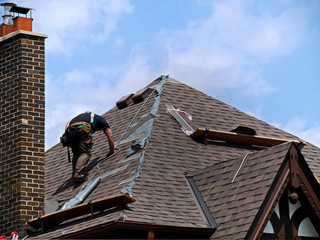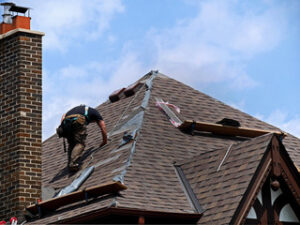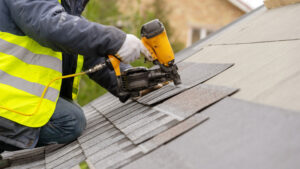The roof is a vital part of your home. It protects your house from rain, snow, wind, and sunlight. It also provides insulation.
Roofing Collegeville PA is tough work. It requires you to be strong, not afraid of heights, and reasonably fit. Before starting a roofing project, ensure you have a stable ladder and maintain three points of contact with the ladder at all times.
Slate

Slate is a beautiful roofing material that gives a home an elegant, timeless look. It is made of natural mineral stones compressed over time to create strong blocks with interlocking edges. It comes in a variety of colors and textures that will complement almost any style of house. Slate roofs are highly durable and can last up to 200 years or more. They are also very resistant to damage from hail and high winds.
Slate roofs require special tools to install and may be more difficult to repair than other roofing materials. Licensed roofers who are familiar with slate will have the specialized equipment necessary to cut, fit, and nail the tiles correctly. This can make installation more labor-intensive, which can increase the overall cost of a slate roof.
Although slate is durable against the elements, it is not as resistant to foot traffic on the roof as other roofing materials. If a roofer walks across your slate roof, it is possible to scratch or break tiles, which can lead to leaks and other problems. If this happens, it may be more difficult to source replacements for the damaged areas, which can add up to a costly repair bill.
If you are looking for a long-lasting, low-maintenance roof, you should consider Brava Old World Slate. This synthetic roofing tile is designed to replicate the look of a traditional slate roof. It is durable, lightweight, insect-resistant and available in 11 colors that will complement any style of house. Its lifetime warranty and Class C fire rating are an added bonus. This roofing solution is a great option for homeowners who are interested in a historic roof, but don’t want to pay the high cost of a natural slate roof.
Metal
Metal roofing has a reputation for being a durable, energy efficient option for commercial and industrial buildings. It’s becoming increasingly popular for residential homes as well. The durability, variety of colors and aesthetic appeal of metal roofs have earned them a place among many Toms River homeowners who prefer a sleek look and the longevity of a metal roof.
Like other roofing materials, there are pros and cons to selecting a metal roof for your home. First, consider the location of your property and the type of weather you experience in your area. Then, decide what type of aesthetic you want for your home and choose the roofing material that fits those needs.
Steel and aluminum are the most common metals used in roofing systems, which can be constructed as either a structural or a decorative option. The way a metal roof is installed will determine the material’s aesthetic and durability. Structural metal roofs are a good choice for buildings or structures that span large lengths and have open framing. These types of metal roofs are often installed with an exposed fastener or lap seam profile, which involves panels that overlap each other and are secured with sealant or exposed screws.
A decorative metal roof uses a snap lock panel system and is installed with a concealed fastener. This type of roof is designed to expand and contract with temperature changes. Concealed fasteners can help to protect the underlayment and prevent water leaks, but they may need to be replaced if they degrade in extreme weather conditions.
Metal roofs are noncombustible and are a safe option in areas that have a high risk of wildfire. However, these roofs do require more support to resist the forces of nature, such as a stronger frame and extra bracing. Also, a metal roof is slippery when wet or covered in snow and can be a safety risk to anyone on the structure.
Tile
Tile is one of the oldest and most beautiful roofing materials. It is usually more expensive than asphalt shingles, but it adds a great deal to the curb appeal and resale value of your home or building. It also holds up well to the extreme weather conditions of the Southwest.
Clay, concrete and slate tiles come in a variety of shapes and colors. Spanish tile, for example, is the classic Southwest roof – it looks like rows of lapping waves with troughs between them to drain rainwater. Other popular tile styles include clay, terra cotta and even fiber-reinforced synthetic tiles.
The durability of a tile roof is unsurpassed. They are not susceptible to the same damage as shingle or wood roofs, but they can still be damaged by hail, strong winds and heavy snowfall. Moreover, the weight of tile roofing can put stress on your building’s structure and foundation.
In addition, tile roofs require regular maintenance and cleaning. They must be inspected regularly to remove any accumulated debris such as leaves, twigs and branches. Moss and algae growth is also a common problem with these types of roofs, especially in shaded areas where the moisture is ideal for their development. A professional can apply biocides to slow their growth.
The insulating qualities of tile roofs are also impressive. They can help moderate indoor temperatures and contribute to a greener, more sustainable living environment.
Asphalt
Asphalt is a popular roofing material for residential homes. It is easy to install and offers a wide range of style options. It is also one of the most affordable roofing materials. However, affordability must be balanced with quality to ensure that you get the best roof for your money.
Asphalt shingles are manufactured to withstand the elements and resist fire, water, wind, and ice. They are often layered together to offer maximum durability. They are designed to be resistant to ultraviolet rays, making them an excellent choice for protecting your home or business from sun damage.
The base of an asphalt shingle is a fiberglass mat that is coated with waterproofing asphalt and topped with ceramic-coated mineral granules. The granules provide color and protection from the sun’s UV rays. The granules also add to the strength of the shingle, as they help to retain the heat and reduce glare.
In addition to being weather-resistant, asphalt shingles are energy efficient. They do not absorb heat like some other roofing materials, which helps to keep indoor temperatures cool and comfortable. However, proper ventilation is required to prolong the life of an asphalt shingle roof and prevent excessive attic temperatures, which can lead to ice dams and premature wear of the shingle surface.
An asphalt shingle roof is a good choice for homeowners who want an attractive and durable roofing solution. In addition to the traditional 3-tab shingles, many manufacturers produce premium shingles that mimic the look of other roofing materials, such as slate and cedar shakes. These shingles are thicker and more expensive than 3-tab shingles, but they offer increased durability and warranty coverage. The shingles are also available in a variety of colors to compliment any home style.
Wood
Wood shakes and shingles offer an organic appearance that adds depth and dimension to your home’s roof. They also offer protection from the elements, including extreme weather and hail, and are resistant to insects and rot. The beauty of wood is that it ages to a distinguished brown or gray color, which enhances your roof’s aesthetics and helps make it stand out among other homes in your neighborhood.
Wooden roofs are usually made of cedar, a durable and strong natural material. Cedar is naturally resistant to insect infestation and rotting, making it one of the most sustainable roofing materials available. Wood shakes and shingles typically last 15 to 30 years before needing replacement.
Although they’re one of the most environmentally friendly roofing options, wood shingles and shakes require more maintenance than other types of roofs. They must be regularly treated with preservatives and protective coatings to prevent rot and mold growth.
When selecting a wood shake or shingle, you’ll want to choose the type that suits your preferences and budget. Wood shingles and shakes come in two varieties: Shakes are thicker and feature a rugged appearance. They’re split by hand, allowing each piece to have a unique grain pattern and ridges that give your home an organic look.
They’re a popular choice for cabins and rustic-style homes, but can be used on any roof. They’re also less expensive than other types of shingles, but they may not be suitable for homes in areas that experience a lot of rain or wildfires.


 Regularly inspecting, cleaning, and clearing debris can prevent long-term issues such as mold, lichen, and moss growth.
Regularly inspecting, cleaning, and clearing debris can prevent long-term issues such as mold, lichen, and moss growth. 
